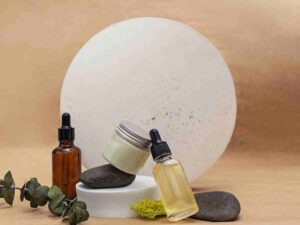Are you passionate about cosmetics? And considering starting a business in the beauty industry, but don’t know where to begin? Well, we got you covered!
Starting a beauty business can be an exciting and rewarding venture. However, like any business, starting a beauty business requires careful planning and a lot of hard work. In 2023, the Cosmetic & Beauty Products Manufacturing industry will generate $48.8 billion in revenue. In this article , I will show you how to start your own beauty business in 12 simple steps.
Get ready to create your own beauty business in the cosmetic industry. Keep reading to learn more.
1. Develop a Business Plan
Developing a business plan is an important tool that helps you start and grow your beauty business. It provides a roadmap for success, helps secure funding, ensures a clear understanding of the market, identifies potential challenges and opportunities, and facilitates decision making. Here are some helpful guides that I would recommend for making a good business plan:
#1 Research And Analyze The Market
Before starting a beauty business, it’s important to conduct market research and analyze competition to identify potential opportunities and challenges. This will help you define your target audience and determine your unique selling proposition. Here are some points to remember when doing research:
- Identify your target audience: Determine the age, gender, income level, and beauty preferences of your ideal customers.
- Analyze your competition: Research your competitors and their pricing, branding, and marketing strategies.
- Determine market trends: Keep up with the latest trends and technologies in the beauty industry to determine what is popular among your target audience.
- Determine market size and growth potential: Analyze the size and growth potential of your target market to determine whether it is a viable opportunity for your beauty business.
- Use various research methods: Gather information through surveys, interviews, focus groups, and online research to get a comprehensive understanding of your market.

#2 Define Your Brand And Product Or Service Offerings
Once you’ve conducted market research, you’ll need to define your brand identity and determine what products or services you will offer. This includes choosing a business name, creating a brand logo and design, and developing your product or service line.

#3 Determine Your Financial Plan
Developing a financial plan is a crucial aspect of any business plan. You’ll need to determine your startup costs, projected revenue, and pricing strategies. I suggest that you should also consider developing a budget for marketing and advertising expenses, as well as managing cash flow and budgeting for future growth.

2. Identify Your Niche
Identifying your niche is a critical step in developing a business plan for your beauty business. Your niche is the specific area of the beauty industry where your products or services will focus. Here are some key aspects to consider when identifying your niche:
#1 Determine Your Area Of Expertise
Consider your knowledge, skills, and experience in the beauty industry. By considering these factors, you’ll be able to determine your area of expertise in the beauty industry, which will help you identify your niche and develop a focused business plan. I recommend that you focus on your area of expertise. It will help you stand out in the market and provide valuable products or services to your customers.

#2 Analyze The Market
Research the market to determine what products or services are in demand and which areas are oversaturated. This will help you identify a gap in the market that you can fill with your niche. For example , by conducting a market analysis that includes both quantitative and qualitative information, a business can gain a deeper understanding of the market it intends to serve.
This table showcases the ideal target market for a hypothetical beauty business line, based on various factors and estimated market size.
Ideal Target Market and Market Size
|
| Age Range (Female) |
Age Range (Male) |
Skin Type |
Lifestyle |
Beauty Preference |
Estimated Market Size (in millions) |
| 18-25 |
– |
Oily |
Active |
Natural Ingredients |
50 |
| 26-35 |
– |
Combination |
Professional |
Anti-aging |
65 |
| 36-50 |
– |
Dry |
Entrepreneur |
Sustainable |
40 |
| 50+ |
– |
Sensitive |
Retired |
Organic |
35 |
| – |
18-25 |
Normal |
Student |
Cruelty-free |
55 |
| – |
26-35 |
Acne-prone |
Traveler |
Fragrance-free |
70 |
| – |
36-50 |
Combination |
Executive |
Plant-based |
45 |
| – |
50+ |
Sensitive |
Retired |
Anti-wrinkle |
30 |
Note: The estimated market size is an approximation and can vary depending on various factors, such as the location and specific target market of the skincare line.
#3 Consider Your Target Audience
Determine the needs and preferences of your target audience. For example, if your target audience is primarily women in their 30s, you may consider offering anti-aging skincare products or services.

#4 Determine Your Unique Selling Proposition (USP)
Your USP (Unique Selling Proposition) is what sets your beauty business apart from the competition. What makes your products or services unique? This could be a specific ingredient, a personalized approach to beauty, or innovative technology.
#5 Test Your Niche
Before launching your beauty business, test your niche by conducting a focus group or offering a small number of products or services. This will help you gauge the market demand and determine if your niche is viable.
3. Choose Your Business Structure
Choosing your business structure is essential when starting a beauty business. It refers to the legal and tax framework under which your business will operate. Here are some key aspects to consider when choosing your business structure:
#1 Identify Your Business Goals And Needs
Determine the goals and needs of your beauty business, such as how much control you want, how much personal liability you’re willing to assume, and what tax implications you’re comfortable with.

#2 Evaluate The Different Business Structures
Research the different business structures available that would fit your business. Here are some examples of business structure:
- Sole proprietorship is a simple and common business structure where one person owns and runs the business with complete control. However, the owner has unlimited personal liability for the business’s debts and legal issues.
- Partnership is a business structure where two or more people share ownership and responsibility for the business. General partners share equal responsibility, while limited partners contribute financially but have no control over the business’s operations.
- Limited Liability Company (LLC) is a flexible and popular business structure that combines the liability protection of a corporation with the tax benefits of a partnership. LLC owners are referred to as members and have limited personal liability for the business’s debts and legal issues.
- Corporation is a separate legal entity from its owners, and shareholders own the business. This structure provides the greatest level of personal liability protection but is also the most complex to set up and maintain.
Here’s a video to learn more about the different business structures:
#3 Consult With A Professional
My advice is to seek advice from a legal and tax professional who can help you determine the best business structure for your beauty business. They can provide guidance on the legal and tax implications of each structure and help you make an informed decision.

4. Register Your Business
Now its time to register your business. Registering your business typically involves legally establishing your business with the relevant government authorities. The specific process and requirements for registering a business can vary depending on your location and the type of business you are starting. Here are some key aspects to consider when registering your business:
#1 Choose A Business Name
Choose a name for your beauty business that is unique and reflects your brand. Ensure the name is not already in use and meets the state’s business naming guidelines. Here are some steps you can take to help you choose a business name:
- Brainstorm: Start by brainstorming ideas for your business name. Think about what you want your business to represent, what products or services you offer, and what sets you apart from your competitors. Write down any words, phrases, or ideas that come to mind.
- Research: Once you have a list of potential names, do some research to see if they are already in use. Search online for similar business names, check with your state’s business registration office to see if the name is available, and check to see if the domain name is available.
- Consider your brand: Your business name should reflect your brand and the image you want to portray to your customers. I suggest that you think about the tone and personality of your brand and make sure your name aligns with that.
- Make it easy to remember and pronounce: A good business name should be easy to remember and pronounce. Avoid names that are too long, difficult to spell, or hard to pronounce.
- Get feedback: Once you have a few potential names, ask for feedback from friends, family, and potential customers. Get their input on which name is most memorable, engaging, and appropriate for your business.
- Check for trademarks: Before you finalize your business name, check to see if it is already trademarked. You don’t want to risk infringing on someone else’s trademark.

#2 Obtain Necessary Licenses And Permits
Determine what licenses and permits you need to operate your beauty business. This could include a business license, sales tax permit, and cosmetology license. The licenses and permits required may vary depending on the type of business you are starting, your location, and the industry you are operating in. I recommend contacting your local government to find out what licenses and permits are required.

#3 Register With The State
If you have all the necessary papers, licences and permits, it is time to register your business. Registering with the state is important because it can protect business owners from personal liability and ensure that they are operating legally and in compliance with state regulations.

5. Determine Your Budget
The time has come to set your budget. It will help you understand the financial requirements of your business and ensures that you have enough funds to cover your expenses and achieve your business goals. Here are some steps you can take to determine your budget:
#1 Identify Your Startup Costs
Your startup costs will include all the expenses required to launch your business. Make a list of all the expenses you anticipate for the first few months of operation. Here are some examples that you may have to consider as a start up costs:
- Equipment and supplies: This can include things like computers, machinery, furniture, tools, and raw materials, depending on the nature of the business.
- Office space and utilities: Renting or leasing office space, as well as costs associated with utilities, such as electricity, heating, and internet.
- Legal fees: This may include expenses related to incorporating the business, obtaining necessary licenses and permits, and consulting with lawyers and accountants.
- Marketing and advertising: This can include expenses associated with developing a brand, creating a website, and promoting the business through various channels, such as social media or paid advertising.
- Employee salaries and benefits: If the business requires staff, startup costs may include salaries, benefits, and training expenses.
- Insurance: This can include general liability insurance, property insurance, and worker’s compensation insurance.
- Licenses and permits: This can include obtaining necessary permits to operate a business, such as a health department permit for a food business.
- Professional fees: This can include fees for accountants, lawyers, and consultants who may be needed to help with various aspects of the business.
#2 Estimate Your Ongoing Expenses
In addition to your startup costs, you’ll need to estimate your ongoing expenses, such as rent, utilities, salaries, and insurance. These costs will vary depending on the size and scope of your business.
#3 Determine Your Revenue Projections
Once you have estimated your expenses, you’ll need to determine your revenue projections. This will help you understand how much revenue you need to generate in order to cover your expenses and make a profit.
#4 Create A Cash Flow Projection
A cash flow projection is a forecast of the cash inflows and outflows of your business over a certain period of time. It helps you understand your cash position and ensures that you have enough funds to cover your expenses.
#5 Set Your Budget
Based on your startup costs, ongoing expenses, revenue projections, and cash flow projection, you can set your budget. Your budget should include all the expenses and revenue projections for the first few months of operation. I suggest that you should account for unexpected expenses or revenue shortfalls.
#6 Monitor And Adjust Your Budget
Once you’ve set your budget, it is important to monitor your actual expenses and revenue against your projections. If you find that you are spending more than expected or generating less revenue, you may need to adjust your budget to ensure that you stay on track.

6. Create a Branding Strategy
A branding strategy helps you establish a clear and consistent identity for your business, which can help you differentiate your business from your competitors and build a strong relationship with your customers. Here are some steps you can take to create a branding strategy:
#1 Define Your Target Audience
Understanding your target audience is the first step in creating a branding strategy. Consider the demographics, interests, and behaviors of your target audience to develop a brand identity that resonates with them.
#2 Develop A Brand Mission And Values
Your brand mission and values should reflect the purpose and principles of your business. Consider what you want to achieve and how you want to make a difference, and use that to develop a mission statement and core values that guide your branding strategy.
#3 Establish A Brand Voice And Tone
Your brand voice and tone should reflect your brand personality and values. Consider how you want your brand to be perceived by your target audience, and use that to guide your language and tone in your marketing and communications.
#4 Develop A Brand Message
Your brand message should be clear, concise, and consistent. I recommend that you develop a message that communicates the key benefits of your products or services, and use it consistently in all of your marketing and communications.
#5 Choose Your Brand Channels
Determine which channels you will use to promote your brand. Consider which channels your target audience uses most frequently, and use that to guide your choices. Here are some examples of the most popular and effective platforms for brand promotion:
- Social media: Social media platforms like Facebook, Instagram, Twitter, and LinkedIn are great for building a brand presence and engaging with your target audience. You can use social media to share content, communicate with your customers, and build a community around your brand.
- Search engines: Search engine optimization (SEO) can help you rank higher on search engines like Google and increase visibility for your brand. You can optimize your website and content to include relevant keywords and phrases that your target audience is searching for.
- Content marketing: Creating high-quality content, such as blog posts, videos, and infographics, can help you establish thought leadership and drive traffic to your website. You can also use content marketing to build brand awareness and engagement through social media and email marketing.

7. Source Manufacturer
Sourcing a manufacturer is the process of finding a company or supplier who can produce and supply your products. This is an essential step when starting a business that involves manufacturing, as it ensures that you have a reliable source for your products. The process of sourcing a manufacturer can be complex and time-consuming, but here are some general steps you can follow:
#1 Evaluate Their Experience and Expertise
Look for a manufacturer that has experience and expertise in your industry or product category. Consider their past clients and projects, as well as their production capabilities and quality standards.

#2 Consider Their Production Capacity
Make sure the manufacturer has the production capacity to meet your needs. Consider their production capacity, lead times, and ability to handle changes in demand.

#3 Assess Their Quality Control Measures
Quality control is critical in ensuring the reliability and consistency of your products. Look for a manufacturer that has robust quality control measures in place, such as testing, inspections, and certifications. Here are some factors to consider when assessing your quality control measures:
- Raw materials and ingredients: Ensure that your raw materials and ingredients are high-quality and meet your specifications. This may involve conducting regular supplier audits or using third-party testing to ensure the quality and consistency of your inputs.
- Manufacturing processes: Evaluate your manufacturing processes to ensure that they are efficient, consistent, and produce high-quality products or services. This may involve conducting regular equipment maintenance and calibration or developing standardized operating procedures for your production staff.
- Quality testing: Establish a system for testing the quality of your products or services to ensure that they meet your standards and customer expectations. This may involve conducting in-house testing or using third-party laboratories or certification programs.
- Packaging and labeling: Ensure that your products are properly labeled and packaged to meet regulatory requirements and customer expectations. This may involve conducting regular inspections of your packaging and labeling or implementing a tracking system to ensure product traceability.
- Training and education: Ensure that your staff is trained and educated on your quality control measures and their role in maintaining quality. This may involve developing training programs or providing ongoing education and support to your staff.

#4 Verify Financial Stability
Choose a manufacturer that is financially stable and has a good reputation in the industry. Consider their payment terms, credit rating, and business history.

#5 Check Their Communication And Customer Service
Good communication and customer service are essential for a successful partnership with your manufacturer. Look for a manufacturer that is responsive, transparent, and easy to work with.

#6 Request References And Reviews
Request references and reviews from the manufacturer’s past and current clients. Consider their feedback and experience with the manufacturer to help inform your decision.
By following the steps outlined above, I guarantee that you will undoubtedly be able to locate the best manufacturer to meet your needs or requirements. If you require professional assistance, please contact Nako Cosmetics.
8. Build Your Team
Building a team is an important step in starting and growing a successful business. Your team is the backbone of your business and can help you achieve your goals and grow your company. Here are some steps you can take to build your team:
#1 Identify Your Staffing Needs
Consider the roles and responsibilities that are required to run your business. Identify the specific skills and experience you need to fill those roles, and create job descriptions that reflect your requirements. Here are some examples of staffing needs that a business may have:
- Administrative staff: These are employees who provide support to the business, such as receptionists, data entry clerks, and administrative assistants.
- Sales staff: These employees are responsible for selling the company’s products or services, and may include sales representatives, account managers, and business development managers.
- Customer service staff: These employees are responsible for interacting with customers, handling inquiries and complaints, and ensuring a positive customer experience.
- Production staff: These are employees who are responsible for creating the company’s products or providing the services that the business offers, such as production workers, technicians, and programmers.
- Management staff: These employees oversee various aspects of the business, including operations, marketing, finance, and human resources.
#2 Develop A Recruitment Strategy
Develop a recruitment strategy that helps you attract top talent. Consider advertising job openings on job boards, social media, or through employee referrals. If you don’t have any knowledge about recruiting, I suggest that you can also partner with a recruitment agency to help you find qualified candidates.
#3 Screen And Interview Candidates
Screen and interview candidates to assess their qualifications, experience, and fit with your company culture. Conduct behavioral interviews to gain insight into their past work experiences and their potential to contribute to your team.
#4 Manage And Develop Your Team
Once you have built your team, it’s important to manage and develop them to ensure they remain engaged and motivated. Set performance goals, provide regular feedback and recognition, and invest in their professional development.

9. Source Your Products and Equipment
Sourcing products and equipment is a critical step in starting and growing a successful business. Sourcing the right products and equipment ensures that you have the resources you need to produce high-quality products and deliver exceptional service. Here are some steps that I recommend that you can follow to source your products and equipment:
#1 Identify Your Needs
Before you start sourcing, identify your needs for products and equipment. Consider the quality and quantity of products you need to produce, the types of equipment required, and the budget you have available.

#2 Research Suppliers
Research potential suppliers online, in trade shows, or by asking for referrals from other businesses in your industry. Consider the supplier’s reputation, quality standards, pricing, and lead times.
#3 Contact Potential Suppliers
Once you have identified potential suppliers, contact them to request information about their products and services. You can also request samples, pricing information, and lead times to evaluate their capabilities.
#4 Evaluate Potential Suppliers
Evaluate potential suppliers based on their capabilities, quality, pricing, and lead times. You can ask for references and conduct a site visit to verify their manufacturing processes.
#5 Negotiate Terms
Negotiate the terms of your agreement, including pricing, lead times, quality standards, and payment terms. Be clear about your expectations and ensure that the terms are clearly outlined in a contract. Here are some examples of negotiating terms that can occur in various business situations:
- Contract negotiations: When negotiating a contract, parties may need to negotiate the terms of the agreement, such as the scope of work, payment terms, intellectual property rights, and termination clauses.
- Supplier negotiations: When negotiating with suppliers, businesses may need to negotiate the price of goods or services, delivery times, quality standards, and payment terms.
- Salary negotiations: When hiring new employees or negotiating salary increases, businesses may need to negotiate salary, benefits, and other compensation-related terms.
- Partnership negotiations: When forming a partnership with another business or individual, parties may need to negotiate the terms of the partnership, such as ownership stakes, responsibilities, and profit-sharing arrangements.
- Lease negotiations: When renting or leasing commercial space, businesses may need to negotiate the lease terms, such as rent, security deposits, lease length, and renewal options.

#6 Manage Logistics
Once you have chosen a supplier, you need to manage the logistics of getting your products and equipment to your location. This includes shipping, customs, and import/export regulations.
#7 Maintain Relationships
Building strong relationships with your suppliers is important for maintaining the quality of your products and equipment. Communicate regularly with your suppliers, provide feedback on their products and services, and make timely payments.
By following the steps above, you will be able to determine where to source your products and equipment. Please contact Nako Cosmetics if you need professional assistance.

10. Develop a Marketing Strategy
A marketing strategy helps you identify your target audience, define your unique value proposition, and create a plan to reach and engage with your customers. Here are some points to determine what marketing strategy to use:
#1 Define Your Target Audience
Defining your target audience refers to the process of identifying and understanding the specific group of people who are most likely to be interested in your products or services. My advice would be to consider factors such as demographics, interests, behaviors, and needs.

#2 Conduct Market Research
Conduct market research to understand your audience’s needs, preferences, and behaviors. Use this information to tailor your marketing messages and tactics to resonate with your audience.

#3 Develop Your Value Proposition
Develop a clear and compelling value proposition that communicates the unique benefits and advantages of your products or services. It is a clear and concise statement that explains what you do, who you serve, and how you solve their problems or meet their needs in a way that differentiates you from competitors.

#4 Define Your Marketing Objectives
Define your marketing objectives and the outcomes you want to achieve. Consider factors such as lead generation, customer acquisition, revenue growth, and brand awareness.
#5 Determine Your Marketing Mix
Determine your marketing mix, which includes the channels and tactics you will use to reach and engage with your target audience. This can include digital marketing, content marketing, social media, email marketing, and events. Here are some points to remember when determining your marketing mix.
- A marketing mix frequently refers to E. Jerome McCarthy’s four Ps: product, price, placement, and promotion.
- All of the components that make up a marketing mix operate together.
- Consumer-centric marketing mixes incorporate a focus on customers into their approaches.
#6 Create A Budget
Create a budget for your marketing activities, taking into account the costs of advertising, content creation, and marketing technology tools.
11. Launch Your Business
Finally, with careful planning, hard work, and dedication, you are now ready to launch your business. Launching your business is an exciting and important step in turning your ideas and plans into a reality. Here are some key steps to consider when launching your business:
#1 Establish Your Legal And Financial Framework
Make sure to register your business and obtain any necessary licenses and permits. Set up your accounting system and establish a bank account.
#2 Know Where To Launch Your Business
When it comes to launching your beauty business, the location can play a key role in its success. The location you choose should align with your target audience and business goals. Here are some options to consider for where to launch your business:
- Online: You can launch your business entirely online, through your website or social media profiles. This can be a cost-effective way to reach a wide audience and offer your products or services globally.
- Home-based: Launching your business from home can help keep costs low and provide flexibility. However, be sure to check local zoning laws and regulations to ensure that you are permitted to run a business from your home.
- Physical storefront: A physical storefront can be a great way to establish a presence in your community and offer a unique customer experience. Consider factors such as foot traffic, accessibility, and parking when selecting a location.
- Pop-up shop: A pop-up shop can be a temporary storefront that allows you to test the market, build brand awareness, and generate revenue without the long-term commitment of a lease. Pop-up shops can be set up in a variety of locations, including vacant storefronts, community centers, and event spaces.
- Mobile business: A mobile business, such as a food truck or mobile salon, can be a great way to offer your services in multiple locations and reach a wider audience.
#3 Develop Your Marketing And Sales Strategies
Develop your marketing and sales strategies to promote your products or services, reach your target audience, and generate revenue. Marketing and sales strategies are essential components of any successful business and involve a range of activities, For example, advertising, branding, lead generation, and customer relationship management.
#4 Establish Your Online Presence
Establishing your online presence means creating a digital footprint for your beauty business. It involves creating a website, social media profiles, and other online platforms that showcase your brand, products or services, and expertise. For starters, I suggest that you start establishing your online presence through social media platforms.

12. Monitor And Adjust
Once your business is launched, it’s important to continuously monitor and adjust your strategies to ensure long-term success. Monitoring and adjusting your business is an ongoing process that requires flexibility, agility, and openness to change. Here are some steps you can take to monitor and adjust your business:
#1 Track Your Performance
Monitor your business performance regularly by tracking metrics such as revenue, expenses, customer acquisition, and engagement. Also, tracking performance in businesses is to identify their strengths, weaknesses, and areas for improvement.
#2 Analyze Your Results
Analyze your results to identify areas where you can improve and make adjustments to your strategies. But before analyzing your results, establish benchmarks for your key performance indicators (KPIs). This will help you understand what your performance data means in the context of your business goals.

#3 Stay Up-To-Date
Keep up-to-date with industry trends and changes, and adjust your strategies as needed to stay competitive. By staying up-to-date, you can ensure that your business is competitive and that you are equipped with the knowledge and skills necessary to succeed in your field.
#4 Seek Feedback
Solicit feedback from your customers, employees, and partners to understand their needs and preferences, and make adjustments accordingly. By seeking feedback, businesses can identify areas of improvement, build stronger relationships with customers, and make more informed decisions.
#5 Experiment With New Strategies
Experiment with new marketing and sales strategies to see what works best for your business. Experimenting with new strategies requires creativity, flexibility, and a willingness to take risks. Here are some examples of new marketing strategies that you might consider:
- Influencer marketing: Partner with influencers who have a large social media following to promote your products or services to their audience.
- Video marketing: Create videos that showcase your products or services and share them on social media or your website.
- Augmented reality (AR) and virtual reality (VR): Use AR (Augmented Reality) or VR (Virtual Reality) technology to create immersive experiences that allow customers to try on makeup or hairstyles virtually.
#6 Adapt To Changing Circumstances
Adapting to changing circumstances is a critical skill for any entrepreneur or business owner, and it’s particularly important in the beauty industry, where trends, preferences, and technologies are constantly evolving. Be prepared to adapt to changing circumstances, such as economic conditions, industry disruptions, or unexpected challenges.
Dive Deeper Into Our Resources
For some insightful reads, we’ve curated a list of recommended articles just for you:
Still haven’t found what you’re looking for? Don’t hesitate to contact us. We’re available around the clock to assist you.
13. Conclusion
Starting a beauty business requires careful planning, hard work, and dedication, but it can be a rewarding and fulfilling venture. By following the steps outlined in this guide, you can create a solid foundation for your business and increase your chances of success.
Alwasy remember that starting a business is a journey that requires flexibility, adaptability, and persistence. In general, launching a business is not simple like going for a stroll in the park; there are ups and downs along the route. Don’t be afraid to contact us at Nako Cosmetic for advice and support if you need it throughout the process.

























